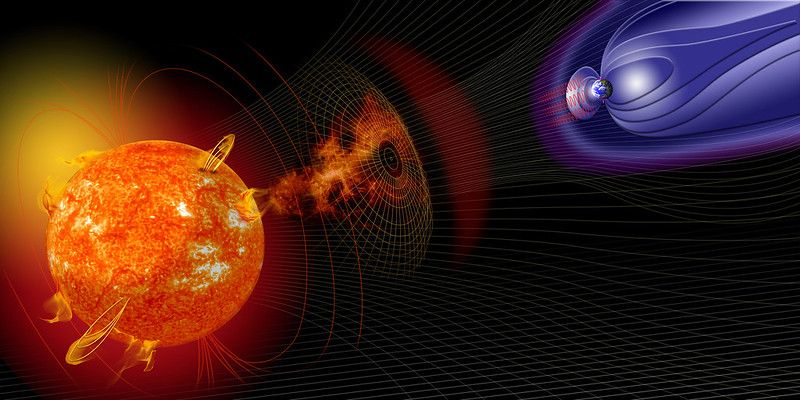
The UK’s ability to predict solar superstorms and other severe space weather events is to get a significant boost with the launch of a major research project involving Leeds expertise.
The research is part of the £20 million, four-year SWIMMR (Space Weather Instrumentation, Measurement, Modelling and Risk) programme, funded by UK Research and Innovation and designed to deliver improved monitoring capability to the UK’s Met Office.
As part of this programme, Leeds is working on a £3.7m effort to better understand the Earth’s upper atmosphere.
Turbulent space weather, largely caused by radiation, energetic particles and plasma emitted by the Sun, can cause huge disruption on Earth.
While the Earth’s magnetosphere – a powerful magnetic field that surrounds the Earth in the upper atmosphere – protects us from day-to-day space weather, extreme events can overcome this planetary defence with potentially severe consequences.
Risks include widespread and long lasting power cuts, disrupted satellite, GPS and radio communication technologies, and air passenger and astronaut safety.
Extreme space weather has been included in the Government’s National Risk Register – an overview of the key emergencies which could cause significant disruption in the UK – since its 2012 update.
“Our state-of-the-art global models will be used to improve space weather monitoring capability.”
Leeds expertise forms part of a University of Birmingham-led consortium drawing together other UK experts in upper atmosphere modelling from Lancaster University, the Universities of Bath, Leicester and Southampton and the British Antarctic Survey.
The technology is capable of predicting space weather with unprecedented speed and accuracy, monitoring the density, winds and temperatures of chemicals in the Earth's atmosphere and triggering warnings when there are likely to be impacts on services and infrastructure.
The first project will explore ways to deliver effective monitoring of the ionosphere, the charged part of the Earth’s upper atmosphere. This region can disrupt communication with aircraft and render GPS positioning systems inoperable.
The second project will investigate the thermosphere, the neutral part of the Earth’s upper atmosphere, which affects the orbits of satellites which, without suitable modelling, can result in satellite collisions.
By the end of the grant the developed models will be deployed operationally at the UK Met Office.
The University of Leeds will bring its experience in whole atmosphere modelling to improve the prediction of variability in the ionosphere and thermosphere.
Professor Dan Marsh, Priestley Chair in Comparative Planetary Atmospheres at Leeds’ Priestley International Centre for Climate, is leading Leeds’ contribution to the project. He said: “Space weather is influenced not only by the Sun, but by weather in the Earth’s troposphere that causes variability throughout the atmosphere. Our state-of-the-art global models, which reach from the surface to the edge of space, will be used to improve space weather monitoring capability.”
“Observations of the ionosphere show changes related to such things as the occurrence of large-scale deep convection in the tropical troposphere,” added Professor Marsh, who is based in Leeds’ School of Physics and Astronomy.
“We hope to improve the prediction of satellite drag and disruption to communications by including previously-omitted lower atmosphere effects such as this in the forecast system."
Announcing the wider SWIMMR programme, Science Minister Amanda Solloway MP said: “Satellites are fundamental to our everyday lives, underpinning technologies we constantly rely on from mobile phones to GPS. Any disruptions caused by space weather can therefore have a profound impact on businesses and individuals.
“These fantastic projects that we are backing today will enhance the UK's ability to forecast space weather, enabling our excellent national weather service to defend the technologies we all depend on.”
Dr Sean Elvidge, from Birmingham’s School of Engineering, said: “The expertise we’ve developed puts us in a great position to make a really significant contribution to the UK’s space weather forecasting capabilities. Only by providing sufficient advance warning, and having robust plans in place for reacting to an extreme event, can we be confident of minimising disruption – and possibly averting disaster.”
Simon Machin, Space Weather Programme Manager at the Met Office, said: “We are very excited by the prospect of working with the crème of UK science and academia on the SWIMMR projects.
“SWIMMR will deliver a step change in UK space weather monitoring, warning and prediction capability by supporting pull-through of cutting-edge science into operational services.
“This will enable the Met Office to provide a greater range of more accurate services driven by the needs of users and underpins the UK’s strategic aims to grow and exploit opportunities in the space domain. SWIMMR communicates a clear vision of cementing the UK as a world leader in space weather and our thanks go out to all partners and stakeholders for supporting this programme of work.”
Further information
The funding forms part of the Strategic Priorities Fund (SPF), delivered by the UK Research & Innovation (UKRI) to drive an increase in high quality multi- and interdisciplinary research and innovation.
The programme is a collaboration led by the Science and Technology Facilities Council (STFC) with Natural Environment Research Council (NERC) and supported by the Department for Business, Energy and Industrial Strategy (BEIS), the Department for Transport and the Ministry of Defence. The programme has been designed in close association with the Met Office Space Weather Operations Centre (MOSWOC).